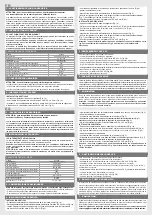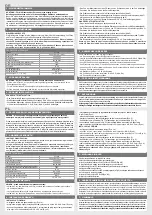
•
fix the flashing base to the column with the 3 dowels and the 3 screws (Fig. 3).
•
pass the cable through the cable fitting.
•
connect the wires of the power cable to the terminal block (Fig. 5).
•
insert the flashing light in the base by sliding it vertically/horizontally (Fig. 7) ,
ensuring that the
flashing light hooks to its rear part (Fig. 8).
•
fix the flashing light with the 2 side screws Ø 2.9 x 6.5 mm (Fig.3).
HORIZONTAL INSTALLATION
•
completely pull off the base of the flashing light (Fig. 1a)
.
•
make 2 additional holes on the back with a Ø 4.5 (Fig. 4).
•
secure the rear of the flashing light to the column with 3 dowels and 3 screws (Fig. 4).
•
pass the cable through the cable fitting.
•
connect the wires of the power cable to the terminal block (Fig. 5).
•
insert the flashing light in the base by sliding it vertically/horizontally (Fig. 7),
ensuring that the
flashing light hooks to its rear part (Fig. 8).
•
fix the flashing light with the 2 side screws Ø 2.9 x 6.5 mm (Fig. 4).
Warning - do not mount the product in locations other than those in Fig. 6 and follow
the specifications of Fig. 5 for the wiring connections.
5 - REPLACEMENT OF THE LEDS
To replace the LEDs, proceed as follows:
• turn off the power supply of the flashing light;
• with the help of a screwdriver remove the 2 side screws
Ø 2,9 x 6,5 (Fig. 3/4).
• extract the flashing body from the base carefully without forcing.
• partially remove the LED strip without forcing the connectors and disconnect the
connector (a.Fig.5) of the strip, then remove it completely.
• partially insert the new LED strip, connect the connector (a.Fig.5) and after insert the strip
fully inside.
• replace the flashing light in the base.
• tighten the 2 side screws
Ø 2,9 x 6,5 (Fig. 3/4).
• restore the electrical power supply.
6 - TESTING AND COMMISSIONING
The testing of the system must be performed by qualified technicians who must perform the tests re
-
quired by relevant legislation related to risks, ensuring compliance with the provisions of the regulations,
in particular the EN12445 standard, which specifies the testing methods for the automation of doors
and gates. Following the successful testing of every (and not just some) device in the system, you can
proceed with the commissioning, following the instructions provided with the main product.
7 - DISPOSAL
At the end of the automation useful life, make sure that the dismantling is carried out by qual
-
ified personnel and the materials are recycled or disposed of according to local regulations
in force. Do not dispose of this product as household waste.
Caution: Parts of the product may contain pollutant or hazardous substances, which,
if disposed, may cause harmful effects on the environment and human health.
1 - SAFETY WARNINGS
WARNING - for the safety of people,it is important to follow
these instructions and save them for future use.
Read the instructions carefully before starting installation. The design and manufacture of
the devices making up the product and the information contained in this manual comply with
safety regulations. However, wrong installation and programming may cause serious physi
-
cal injury to those who perform the work and those who will use the device. For this reason,
during installation, it is important to carefully follow all instructions in this manual.
2 - PRODUCT OVERVIEW
INDICATOR FLASHING LIGHT
The Eclipse flashing light is a signaling device applicable to the automation of doors and
gates, garage doors and barrier gates.
Warning: any use other than the one described, and carried out under environmental
conditions other than the ones described in this manual, is to be considered improper
and prohibited.
Warning - The data and information provided in this manual are subject to change at
any time without notice by Key Automation S.r.l.
TECHNICAL CHARACTERISTICS
3 - PRELIMINARY CHECKS
Before installing this product, verify and check the following steps:
• Make sure that the surface where the device is going to be secured is solid and does not
allow vibration
• Use electrical connections suitable for the electric requirements.
4 - PRODUCT INSTALLATION
VERTICAL INSTALLATION
•
completely pull off the base of the flashing light (Fig. 1a).
•
secure the rear of the flashing light to the base with the 2 screws Ø 3.9 x 9.5 mm (Fig. 1b).
•
make 2 additional holes with a Ø 3 and secure the rear of the flashing light to the base
with the 2 additional screws Ø 3.9 x 9.5 mm (Fig.2).
IT
EN
•
fissare alla colonna la base lampeggiante tramite i n.3 tasselli e n. 3 viti (Fig. 3).
•
far passare i fili nel passacavo.
•
collegare i fili del cavo di alimentazione alla morsettiera (Fig. 5).
•
inserire il lampeggiante nella base facendolo scorrere verticalmente/orizzontalmente (Fig.7)
assicurandosi che il lampeggiante si agganci al retro (Fig. 8).
•
fissare il lampeggiante con le n.2 viti laterali Ø 2,9 x 6,5 mm (Fig.3).
INSTALLAZIONE ORIZZONTALE
•
sfilare completamente la base del lampeggiante (Fig. 1a) .
•
eseguire sul retro del lampeggiante n.2 fori supplementari con punta
Ø 4,5 (Fig. 4).
•
fissare il retro del lampeggiante alla colonna con n.3 tasselli e n.3 viti (Fig. 4).
•
far passare i fili nel passacavo.
•
collegare i fili del cavo di alimentazione alla morsettiera (Fig. 5).
•
inserire il lampeggiante nella base facendolo scorrere verticalmente/orizzontalmente (Fig.7)
assicurandosi che il lampeggiante si agganci al retro (Fig. 8).
•
fissare il lampeggiante con le n.2 viti laterali Ø 2,9 x 6,5 mm (Fig. 4).
Attenzione - non montare il prodotto in posizioni diverse da quelle in Fig. 6 e rispettare le
indicazioni della Fig. 5 per effettuare i collegamenti dei cavi elettrici.
5 - SOSTITUZIONE DEI LED
Per sostituire i led, procedere nel seguente modo:
• togliere l’alimentazione elettrica al lampeggiante.
• con l’aiuto di un cacciavite svitare le 2 viti laterali
Ø 2,9 x 6,5 (Fig. 3/4).
• estrarre il corpo lampeggiante dalla base prestando attenzione a non sforzare.
• sfilare parzialmente la striscia led senza sforzare i connettori e scollegare il connettore
(a Fig.5) della striscia, e sfilarla completamente.
• inserire parzialmente la nuova striscia led, collegare il connettore (a.Fig.5) e inserirla completamente.
• riposizionare il lampeggiante nella base.
• avvitare le 2 viti laterali
Ø 2,9 x 6,5 (Fig. 3/4)
.
• ricollegare l’alimentazione elettrica.
6 - COLLAUDO E MESSA IN SERVIZIO
Il collaudo dell’impianto va eseguito da un tecnico qualificato che deve effettuare le prove
richieste dalla normativa di riferimento in funzione dei rischi presenti, verificando il rispetto di
quanto previsto dalle normative, in particolare la norma EN12445 che indica i metodi di prova
per gli automatismi per porte e cancelli. A seguito del positivo collaudo di tutti (e non solo di
alcuni) i dispositivi dell’impianto si può procedere con la messa in servizio, seguendo le indica
-
zioni riportate nelle istruzioni del prodotto principale.
7 - SMALTIMENTO
Al termine della vita dell’automazione, assicuratevi che lo smantellamento sia eseguito da per
-
sonale qualificato e che i materiali vengano riciclati o smaltiti secondo le norme valide a livello
locale. E’ vietato gettare questo prodotto nei rifiuti domestici.
Attenzione: alcune parti del prodotto possono contenere sostanze inquinanti o perico-
lose che, se disperse, potrebbero provocare effetti dannosi sull’ambiente e sulla salute
umana.
1 - AVVERTENZE PER LA SICUREZZA
ATTENZIONE - per la sicurezza delle persone è importante rispettare
queste istruzioni e conservarle per utilizzi futuri.
Leggere attentamente le istruzioni prima di eseguire l’installazione. La progettazione e la fab
-
bricazione dei dispositivi che compongono il prodotto e le informazioni contenute nel presente
manuale rispettano le normative vigenti sulla sicurezza. Ciò nonostante un’installazione e una
programmazione errata possono causare gravi ferite alle persone che eseguono il lavoro e a
quelle che useranno l’impianto. Per questo motivo, durante l’installazione, è importante seguire
attentamente tutte le istruzioni riportate in questo manuale.
2 - INTRODUZIONE AL PRODOTTO
LAMPEGGIANTE DI SEGNALAZIONE
Il lampeggiante Eclipse è un dispositivo di segnalazione applicabile all’automazione di porte e
cancelli, portoni di garage e barriere stradali.
Attenzione - qualsiasi altro uso diverso da quello descritto e in condizioni ambientali
diverse da quelle riportate in questo manuale è da considerarsi improprio e vietato.
Attenzione - i dati e le informazioni indicate in questo manuale sono da ritenersi su
-
scettibili di modifica in qualsiasi momento e senza obbligo di preavviso da parte di Key
Automation S.r.l.
CARATTERISTICHE TECNICHE
3 - VERIFICHE PRELIMINARI
ATTENZIONE - prima di installare il prodotto verificare e controllare i seguenti punti:
• verificare che la superficie su cui fissare il dispositivo sia solida e non permetta vibrazioni
• utilizzare collegamenti elettrici adeguati alle correnti richieste
• verificare che l’alimentazione rispetti i valori delle caratteristiche tecniche
4 - INSTALLAZIONE DEL PRODOTTO
INSTALLAZIONE VERTICALE
•
sfilare completamente la base del lampeggiante (Fig. 1a).
•
fissare il retro del lampeggiante alla base tramite le n.2 viti Ø 3,9 x 9,5 mm (Fig. 1b).
•
eseguire n.2 fori supplementari con punta Ø 3 e fissare il retro del lampeggiante alla base
con n.2 viti supplementari Ø 3,9 x 9,5 mm (Fig.2).
modello
Eclipse
alimentazione
24 Vac/Vdc - 3 W (max)
luce di cortesia
24 Vac/Vdc
lampeggiante
24 Vac/Vdc
frequenza antenna
433,92 MHz
ciclo massimo funzionamento (lampeggiante)
50%
ciclo massimo funzionamento (luce di cortesia)
100%
grado di protezione
IP 44
temperatura funzionamento
-20° +50° C
colore (lampeggiante)
Ambra
colore (luce di cortesia)
Bianco
dimensioni (L - P - H mm)
75 - 98 - 190
model
Eclipse
power supply
24
Vac/Vdc - 3 W (max)
courtesy light
24
Vac/Vdc
flashing light
24
Vac/Vdc
antenna frequency
433.92 MHz
maximum operation cycle (flashing light)
50%
maximum operation cycle (courtesy light)
100%
degree of protection
IP 44
operating temperature
-20° +50° C
color (flashing light)
Amber
color (courtesy light)
White
dimensions (L - D - H mm)
75 - 98 - 190


























